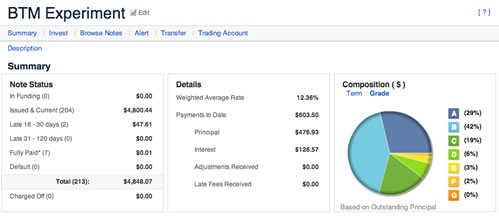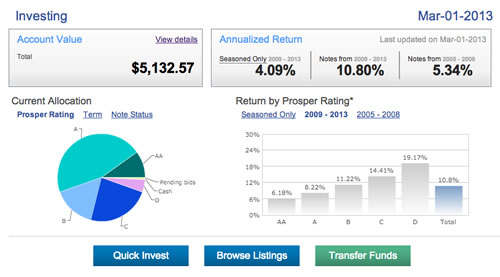Here’s the 3rd and last piece of the monthly updates for my Beat the Market Experiment, a set of three real money portfolios started on November 1st, 2012. See also my $10,000 Benchmark and $10,000 Speculative portfolio updates for March 2013.
For this one, I started with $10,000 split evenly between Prosper Lending and Lending Club, and went to work lending other people money and earning interest with an 8% target net return.
$5,000 LendingClub Loan Portfolio. Below is a screenshot of my LendingClub account as of 3/1/13. I’ve had loans at LC before, but sold them all on the secondary market and started fresh for this tracking experiment. Here are screenshots of my total balance and my portfolio details. I would say my overall risk level is moderate-conservative with mostly A and B rated loans (top two grades).
The portfolio is now 4 months old, with 206 currently active loans, 7 loans that were paid off early, and one is in funding. Two of the active loans are currently between 16-30 days late. The current weighted average interest rate is 12.36%, which means I can lose 4.36% to defaults and still net an 8% return.
I pick loans using a preset filter based on my LendingClub filters post as well as my Prosper filter research noted below. I never spend any time reading individual loan descriptions, as I’m trying to keep this mostly passive and scalable. The filters are saved online and it takes just a minute to reinvest interest, although I still tend to forget until I do these updates. In additional to outstanding loan principal, the account also has $249 in idle cash, $25 in funding limbo, and $38 in accrued interest.
LendingClub.com account value: $5,160 (includes principal + accrued interest, after fees)
$5,000 Prosper.com Loan Portfolio. Below are screenshots of my Prosper account page as of 3/1/13.
My Prosper portfolio now has 213 currently active loans, 9 loans that were paid off early, and one in funding. One of the active loans is between 1-30 days late, one loan that was late last month went back to current. That makes 2 loans so far that were late which went back to current. Prosper tells me that my current annualized return is 10.8%, so I’m guessing that’s my weighted average interest rate. This portfolio is also mostly loans from their top two grades.
I use Prosper’s free Quick Invest feature which automatically uses any free cash to invest in loans that satisfy my preset criteria (see my Prosper loan filters post for details). Essentially, I have automatic dividend reinvestment.
Prosper.com account value: $5,133 (includes principal + accrued interest, after fees)
Total P2P loan value: $10,293 (includes principal + accrued interest, after fees)
I know this isn’t the same as reporting the actual liquid value of the loans, but it’s the best I can do for now. To stay on the conservative side, I plan to assume that any loan that is 30 days late will be a full default of all remaining principal. So far, none of my loans are 30 days late, although I’m sure it will happen sooner or later.


 The Best Credit Card Bonus Offers – 2025
The Best Credit Card Bonus Offers – 2025 Big List of Free Stocks from Brokerage Apps
Big List of Free Stocks from Brokerage Apps Best Interest Rates on Cash - 2025
Best Interest Rates on Cash - 2025 Free Credit Scores x 3 + Free Credit Monitoring
Free Credit Scores x 3 + Free Credit Monitoring Best No Fee 0% APR Balance Transfer Offers
Best No Fee 0% APR Balance Transfer Offers Little-Known Cellular Data Plans That Can Save Big Money
Little-Known Cellular Data Plans That Can Save Big Money How To Haggle Your Cable or Direct TV Bill
How To Haggle Your Cable or Direct TV Bill Big List of Free Consumer Data Reports (Credit, Rent, Work)
Big List of Free Consumer Data Reports (Credit, Rent, Work)
What are the tax implications when investing in either of these companies? What flavor of 1099 do they send? Is it a plain ol’ 1099-DIV or 1099-INT, or something more exotic?
Nevermind. I answered my own question.
http://www.lendingclub.com/kb/index.php?View=entry&EntryID=240
Nice job on the two peer-to-peer lending portfolios! I think it has been really facscinating watch you compare each of the market leaders in peer-to-peer lending with other benchmark portfolios. Certainly a nice exercise in diversification and the differences between asset classes!
Personally, when tracking my accounts I generally don’t include the accrued interest (just a personal preference) and instead look at things from a “cash basis” perspective, only counting the interest received net of fees, charge-offs, and defaults.
Looking forward to continuing to track this project!
Hey Jonathan, how do you feel about using Lending Club or Prosper for retirement accumulation? I noticed that both offer IRAs. My wife and I are in our early thirties, and she has $20,000 in a 401(k) we’re looking to roll over (and slowly convert to Roths). I’m considering putting a portion of that money into a Prosper or Lending Club IRA as a way to diversify the approximately $85,000 we currently have in retirement accounts.
@Thomas B – In my opinion, P2P investments are still not completely proven for me to put in any large amount of my retirement saving into it. That’s why I started this experiment, which only uses a small percentage of my overall portfolio, as a way for me to get my head around using it for more money in the future.
@S K – As a general rule, the interest is taxable as ordinary income (like bank account and taxable bond interest) unless held in an IRA, and you can deduce the losses from defaulted loans.
I’ve been using LC since 2008 and I’ve found to be a reliable service. However, for a taxable account it is disaster. Interest must be reported as regular income, but defaults must be reported as capital losses. See pages 66-70 of the prospectus. Read and understand this section, particularly the comments at the bottom of page 70 on worthless notes.
In my case, the taxable income in 2012 was about 180% of my net income. So with actual net income (net of write offs) I received $10,000, but I will pay regular income tax on $18,000, and have capital losses of $8,000. Even if I had capital gains of $8,000 (which I don’t) we’re arbitraging the tax rates in the wrong direction!
LC has performed the nifty trick of turning capital losses into regular income – a tax disaster! That said, in a non-taxable account, such as an IRA, it would be a non-issue.